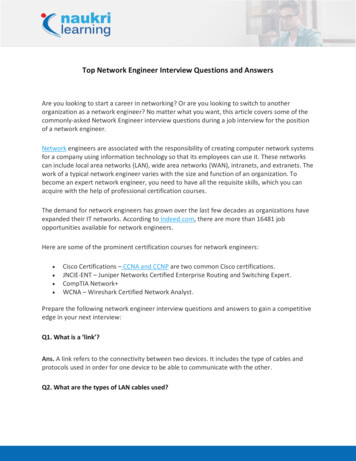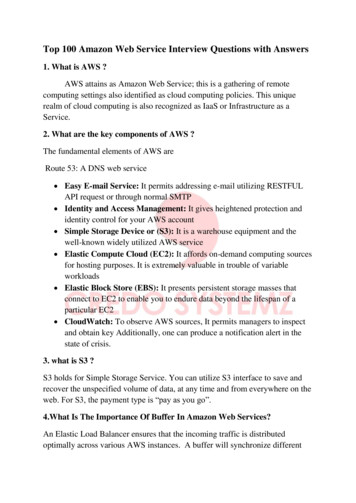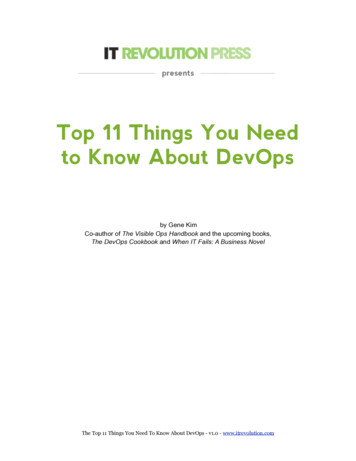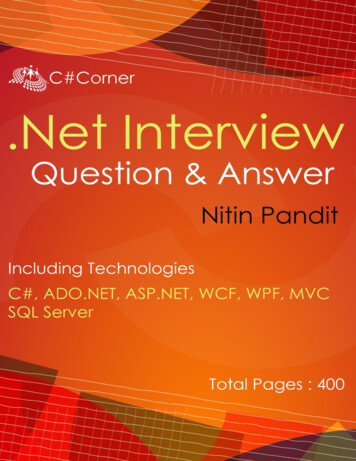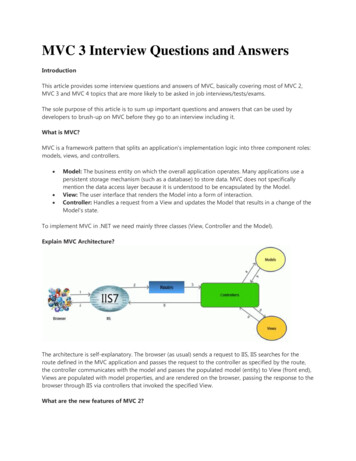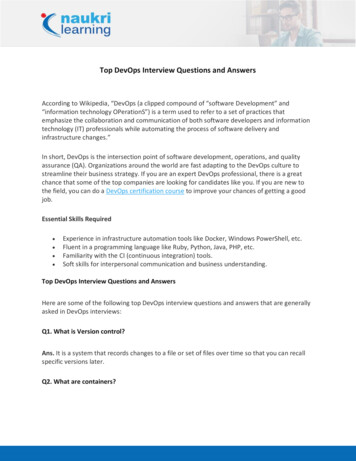
Transcription
Top DevOps Interview Questions and AnswersAccording to Wikipedia, “DevOps (a clipped compound of “software Development” and“information technology OPerationS”) is a term used to refer to a set of practices thatemphasize the collaboration and communication of both software developers and informationtechnology (IT) professionals while automating the process of software delivery andinfrastructure changes.”In short, DevOps is the intersection point of software development, operations, and qualityassurance (QA). Organizations around the world are fast adapting to the DevOps culture tostreamline their business strategy. If you are an expert DevOps professional, there is a greatchance that some of the top companies are looking for candidates like you. If you are new tothe field, you can do a DevOps certification course to improve your chances of getting a goodjob.Essential Skills Required Experience in infrastructure automation tools like Docker, Windows PowerShell, etc.Fluent in a programming language like Ruby, Python, Java, PHP, etc.Familiarity with the CI (continuous integration) tools.Soft skills for interpersonal communication and business understanding.Top DevOps Interview Questions and AnswersHere are some of the following top DevOps interview questions and answers that are generallyasked in DevOps interviews:Q1. What is Version control?Ans. It is a system that records changes to a file or set of files over time so that you can recallspecific versions later.Q2. What are containers?
Ans. Containers are a form of lightweight virtualization, heavier than ‘chroot’ but lighter than‘hypervisors’. They provide isolation among processes while using the same kernel as the hostmachine, and ‘cgroups’ functionality within the kernel.Q3. What is Continuous Delivery?Ans. It is the practice of delivering the software for testing as soon as it is built by CI(Continuous Integration) servers.Q4. What are the uses of Version control?Ans. Revert files back to a previous state.Revert the entire project back to a previous state.Compare changes over time.See who last modified something that might be causing a problem.Who introduced an issue and when.Q5. What are the core operations of DevOps in terms of development and Infrastructure?Ans. The core operations of DevOps are application development, code developing, codecoverage, unit testing, packaging, deployment with infrastructure, provisioning, configuration,orchestration, and deployment.Become a Master of DevOps by going through this online Devops Plus TrainingQ6. Can one consider DevOps as an Agile methodology?Ans. DevOps can be considered complementary to the agile methodology, but not completelysimilar.Get a clear understanding of DevOps through this What is DevOps and why is it important?Q7. Name some of the top tools used in DevOps? What are the tools that you have used?Ans. Some of the common tools are – Docker, Git, Selenium, Puppet, Nagios, and Chef
Q8. What is Git?Ans. Git is a Distributed Version Control system (DVCS). It can track changes to a file and allowsyou to revert back to any particular change.Q9. In Git how do you revert a commit that has already been pushed and made public?Ans. It can be done in two ways: By removing or fixing the bad file in a new commit and pushing it to the remoterepository. Once the necessary changes to the file has been made, commit it to theremote repository. Use: git commit -m “commit message”By creating a new commit that undoes all changes that were made in the bad commit.To do this, use command: git revert name of bad commit Q10. What is Git bisect?Ans. Git bisect is used to find the commit that introduced a bug by using binary search.Q11. Why do you need a Continuous Integration of Dev & Testing?Ans. Continuous Integration of Dev and Testing improves the quality of software and reducesthe time taken to deliver it, by replacing the traditional practice of testing after completing alldevelopment.Q12. Which is the most popular scripting language in DevOps?Ans. Python.LEARN DEVOPS NOW Q13. What is Vagrant and what is it used for?Ans. A vagrant is a tool that can create and manage virtualized (or containerized) environmentsfor testing and developing software.Q14. What is post mortem meetings?
Ans. It is done to discuss what went wrong and what steps should be taken so that failuredoesn’t happen again.Q15. What is meant by Continuous Integration?Ans. It is a development practice that requires developers to integrate code into a sharedrepository several times a day.Q16. What’s a PTR in DNS?Ans. Pointer (PTR) record is used for reverse DNS (Domain Name System) lookup.Q17. What testing is necessary to ensure a new service is ready for production?Ans. Continuous testingAlso Read Top Python Interview Questions with AnswersQ18. What is Continuous Testing?Ans. Continuous Testing is the process of executing automated tests as part of the softwaredelivery pipeline to obtain immediate feedback on the business risks associated with the latestbuild.Q19. What is Automation Testing?Ans. Automation testing or Test Automation is a process of automating the manual process totest the application/system under test.Q20. What are the key elements of continuous testing?Ans. Risk assessment, policy analysis, requirements traceability, advanced analysis, testoptimization, and service virtualizationQ21. What are the Testing types supported by Selenium?
Ans. Regression testing and functional testingAlso Read Top Selenium Interview Questions & AnswersQ22. Differentiate between Asset Management and Configuration ManagementAns. Asset Management, broadly defined, refers to any system that monitors and maintainsthings of value to an entity or group.Configuration Management is the process of planning for, identifying, controlling, and verifyingthe Configurations Items (CIs) within a service, recording their status, and, in support of ChangeManagement, assessing the potential IT impact of changing those items.Q23. What is Puppet?Ans. It is a Configuration Management tool which is used to automate administration tasks.Q24. How does HTTP work?Ans. The HTTP protocol works in a client and server model like most other protocols. A webbrowser using which a request is initiated is called as a client and a web server software whichresponse to that request is called a server. World Wide Web Consortium and the InternetEngineering Task Force are two important spokes in the standardization of the HTTP protocol.Q25. Describe two-factor authentication?Ans. Two-factor authentication is a security process in which the user provides two means ofidentification from separate categories of credentials; one is typically a physical token, such as acard, and the other is typically something memorized, such as a security code.Q26. Which language is used in Git?Ans. Git is written in C. It is very fast and reduces runtimes overhead.Q27. Suppose you just made a bad Git commit and made it public, how would you revert it?
Ans. The command to revert the Git commit is –Ans. git revert commit hash This command can revert any commands just by adding the commit ID.Q28. What is SubGit?Ans. SubGit is an open-source, version control tool for migrating Subversions (SVN) to Git. Itallows creating a writable Git mirror of a Subversion repository, which can then be used to pushto Git.Q29. What is Ansible?Ans. Ansible is an open-source automation platform. It is a powerful yet very simple to setup.Ansible facilitates complex tasks like configuration management, IT orchestration, applicationdeployment, and task automation.Take charge of your career by going through our professionally designed Devops ExtensiveTraining now.Q30. What is the use of Ansible?Ans. Ansible is used primarily in IT infrastructure for configuration management andautomatically deploying software applications to remote nodes.Q31. Explain the advantages of Ansible.Ans. Free of costAgentlessVery low uptimeGood performanceIdempotentVery easy to learnEasy to pick upDeclarative, not procedural
Doesn’t require custom security infrastructureQ32. Describe IaC.Ans. IaC is the abbreviation for Infrastructure as Code. It manages and tracks infrastructureconfiguration in files and allows better and scalable infrastructure configuration. It ensurestransparent tracking of changes through the versioning system.Q33. What is configuration management?Ans. It is a combination of practices and tools to automate the delivery and operation ofinfrastructure. It is used to – Model infrastructureMonitor and enforce desired configurationsAutomatically remediate any unexpected configuration driftConfiguration management helps to expedite the software delivery process and deliver bettersoftware.Q34. What is Jenkins?Ans. Jenkins is an open-source continuous integration server that facilitates achieving aContinuous Integration process in an automated manner. It is also capable to highlight anyerrors in the project in its early stages.Q35. Name some useful plugins in Jenkins.Ans. Dashboard View PluginView Job Filters PluginExclusionGitHub/GitLab Pull Request BuilderHudson Extended Read Permission PluginPost build taskAmazon EC2HTML publisherCopy artifact
JDK Parameter PluginJob Configuration History PluginParameterized Trigger pluginQ36. What is a Virtual Private Cloud?Ans. Virtual Private Cloud offers the flexibility to scale and control the workloads. It providesglobal access to manage workloads when you connect your on-premises or remote resources toGoogle Cloud Platform (GCP).Q37. What is ‘Canary Release’?Ans. Canary rRelease refers to a pattern that reduces the risk of introducing a new versionsoftware into the production environment. It is made available to the subset of the user andthen to the complete user set.Q38. What is Docker?Ans. Docker is a tool to easily create, deploy, and run applications using containers. It packagesan application with all its dependencies to ensure its seamless running. Docker allowsapplications to use the same Linux kernel they are already running on.Interested in learning DevOps? Click here to learn more about this DevOps Certified Course!Q39. On which platforms does a Docker run?Ans. Docker runs only on Linux and Cloud platforms, which are –Linux – Ubuntu 12.04 LTS Fedora 20 RHEL 6.5 CentOS 6 GentooArchLinuxopenSUSE 12.3 CRUX 3.0
Cloud – Amazon EC2Google Compute EngineMicrosoft AzureRackspaceQ40. What is a Docker image?Ans. Docker images are used to create containers and comprise of multiple layers for codeexecution.Q41. How will you launch a browser using WebDriver?Ans. There is a simple formula to launch a browser using WebDriver, which changes as per thebrowser name.For Chrome –WebDriver driver new ChromeDriver();For Firefox –WebDriver driver new FirefoxDriver();For Internet Explorer (IE) –Become Devops Certified!WebDriver driver new InternetExplorerDriver();Q42. Which Source Code Management (SCM) tools does Jenkins support?Ans. Jenkins supports the following SCM tools – AccuRevClearcase
CVSGitMercurialPerforceRTCSubversionQ43. What is Chef?Ans. The chef is a powerful automation platform for transforming infrastructure into code. Italso helps in writing scripts for automating IT processes.Q44. Explain the architecture of Chef.Ans. Chef comprises of – Chef Server – Also regarded as the central store for configuration data of infrastructure,and allows to dynamically drive node configuration based on data.Chef Node – These are referred to as clients as they run the Chef-client software.Chef Workstation – It is the place where users can interact with the Chef, develop andtest cookbooks and recipes, and modify other configuration data.Q45. What is Recipe in Chef?Ans. A Recipe is a collection of Resources that configures a software package or infrastructure.The functions of a Recipe is – Installing and configuring software componentsManaging filesDeploying applicationsExecuting other recipesQ46. How is a Cookbook different from a Recipe in Chef?Ans. A Recipe is a collection of Resources to configure a software package or infrastructure,while a Cookbook comprises of a collection of Recipes and other information in a systematicand manageable manner.Q47. What is Nagios Log Server?
Ans. It is an enterprise-class log monitoring and management application and is very powerfulin nature. Nagios Log Server facilitates viewing, sorting, and configuring logs from any source onany network. It also analyzes, collects, and stores log data as per requirements and offerextended data insight about the network infrastructure.Q48. What are the benefits of using Nagios Log Server?Ans. Automatically fixes problemsEasy coordination with the tech team responsesEnsures minimal impact of any IT infrastructure outagesMeets the client-business service-level agreementsMonitors business processes and infraPlans infrastructure upgrades before any failureGives quick response to issuesLearn all about DevOps from this comprehensive DevOps plus course!Q49. What is NRPE?Ans. It is the abbreviation for ‘Nagios Remote Plugin Executor’, and helps the users to monitorremote machine performance metrics by using Nagios plugins remotely on other Linux or Unixdevices.Q50. Tell me what is kubectl.Ans. It is a command-line interface to run commands against Kubernetes clusters, deployapplications, manage cluster resources, and view logs.Q51. What is the use of Continuous Monitoring?Ans. With the help of Continuous Monitoring, a user can easily detect and measure the securityimplications for any unplanned changes and assesses the vulnerabilities in case of anyinformation threat.Q52. How will you do Continuous Monitoring?
Ans. Continuous Monitoring is done with the help of Application Performance Management(APM). APMs monitor, analyze, and manage all types of applications and IT infrastructure.Q53. What are some deployment patterns?Ans. The most popular and advanced deployment pa
Top DevOps Interview Questions and Answers Here are some of the following top DevOps interview questions and answers that are generally asked in DevOps interviews: Q1. What is Version control? Ans. It is a system that records changes to a file or set of files over time so that you can recall specific versions later. Q2. What are containers?

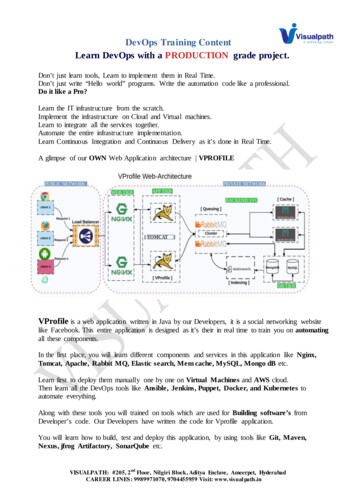
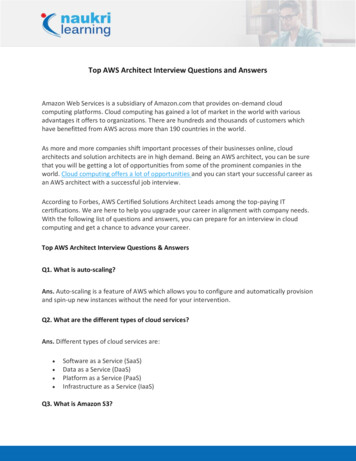
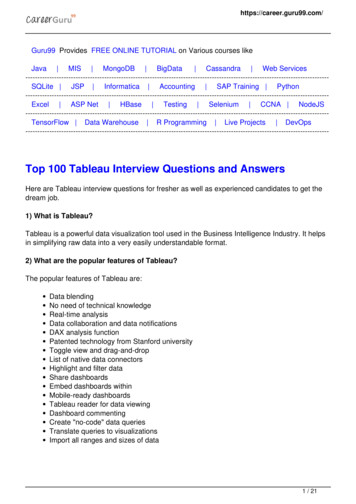
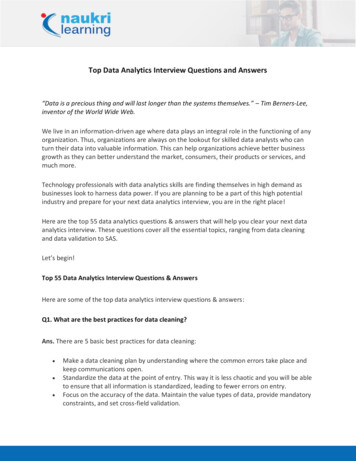
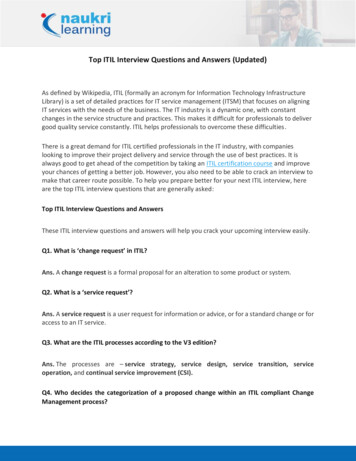
![Top Networking Interview Questions and Answers [Updated]](/img/3/top-networking-interview-questions-and-answers-updated.jpg)
